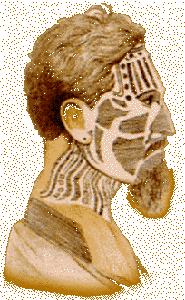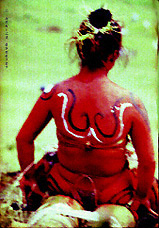RONGORONGO

Rongo-rongo is the hieroglyphic script of Easter Island. It has remained a mystery since its discovery. For over a hundred years, controversy has raged over the meaning and source of these enigmatic characters.

Rongo-rongo Tablet
There are only 21 known tablets in existence - scattered in museums and private collections. Tiny, remarkably regular glyphs, about one centimeter high, highly stylized and formalized, are carved in shallow grooves running the length of the tablets. Oral tradition has it that scribes used obsidian flakes or shark teeth to cut the glyphs and that writing was brought by the first colonists led by Hotu Matua. Last but not least, of the twentyone surviving tablets three bear the same text in slightly different "spellings", a fact discovered by three schoolboys of St Petersburg (then Leningrad), just before World War II.
In 1868 newly converted Easter Islanders send to Tepano Jaussen, Bishop of Tahiti, as a token of respect, a long twine of human hair, wound around an ancient piece of wood. Tepano Jaussen examines the gift, and, lifting the twine, discovers that the small board is covered in hieroglyphs.
The bishop, elated at the discovery, writes to Father Hippolyte Roussel on Easter Island, exhorting him to gather all the tablets he can and to seek out natives able to translate them. But only a handful remain of the hundreds of tablets mentioned by Brother Eyraud only a few years earlier in a report to the Father Superior of the Congregation of the Sacred Heart.
Some say they were burnt to please the missionaries who saw in them evil relics of pagan times. Some say they were hidden to save them from destruction. Which side should we believe? Brother Eyraud had died in 1868 without having ever mentioned the tablets to anyone else, not even to his friend Father Zumbohm, who is astounded at the bishop's discovery. Monsignor Jaussen soon locates in Tahiti a laborer from Easter Island, Metoro, who claims to be able to read the tablets. He describes in his notes how Metoro turns each tablet around and around to find its beginning, then starts chanting its contents.
The direction of writing is unique. Starting from the lefthand bottom corner, you proceed from left to right and, at the end of the line, you turn the tablet around before you start reading the next line. Indeed, the orientation of the hieroglyphs is reversed every other line. Imagine a book in which every other line is printed backtofront and upsidedown. That is how the tablets are written! Jaussen was not able to decipher the tablets.

There are also many zoomorphic figures, birds especially, fish and lizards less often. The most frequent figure looks very much like the frigate bird, which happens to have been the object of a cult, as it was associated with MakeMake, the supreme god.
When you compare the tablets which bear the same text, when you analyze repeated groups of signs, you realize that writing must have followed rules. The scribe could choose to link a sign to the next, but not in any old way. You could either carve a mannikin standing, arms dangling, followed by some other sign, or the same mannikin holding that sign with one hand. You could either carve a simple sign (a leg, a crescent) separate from the next, or rotate it 90 degrees counterclockwise and carve the next sign on top of it.
All we can reasonably hope to decipher some day is some two to three lines of the tablet commonly called
Mamari. You can clearly see that they have to do with the moon. There are several versions of the ancient lunar calendar of Easter Island.
PETROGLYPHS 
On Easter Island, petroglyphs are located in every sector of the island where there are suitable surfaces. Favored locations are smooth areas of lava flow (called "papa" in Rapanui), or on smooth basalt boulders. Most of these surfaces occur along coastal areas and often are associated with major ceremonial centers. Some important ahu have, as part of their structure, elegantly carved basalt stones (pa'enga), with petroglyphs on them. Paintings survive in caves or in some of the stone houses at 'Orongo where they are protected against the weathering process.
Thousands of petroglyphs - rock carvings - can be found on Easter Island. Many represent animals, notably birds or anthropomorphic birdmen.
One of the most famous motifs on Easter Island is that of birdman - a half-man, half bird image that was connected to cult events at the sacred site of 'Orongo. A bit of background on the culture is necessary to explain this unusual cult.
After the demise of the statue building, in the last days before the invasion by Peruvian slave traders, there arose a cult of the Birdman (Tangata Manu). The birdman was seen as the representative on earth of the creator god Makemake, and eventually, this cult surpassed the traditional power of the king
ariki.

Once a year, representatives from each clan would gather at the ceremonial village of Orongo and swim to Motu Nui, a nearby Islet to search for the egg of the Sooty Tern. On his return, the competitor presented the egg to his representative who was then invested with the title of
Tangata Manu. He then went down to Mataveri and from there was led in procession to the southwest exterior slope of Rano Raraku, where he remained in seclusion for a year. The Birdman ritual was still in existence when Europeans arrived on Easter Island - therefore historically documented. It was also featured quite prominently in Kevin Costner's film "Rapa Nui".
In Hanga Roa -a sprawling and pleasant community where the island's 2,775 residents live because it's the only area on the island with electricity and running water. The most interesting souvenirs are miniature wood and stone carvings of moais, though some stone samples up to 6 feet tall are available.

Moai Kavakava
A bearded emaciated man whose ribs and vertebrae are grotesquely extended.
It is said to represent the spirits of dead ancestors.
According to the local tradition, as Chief Tuu-ko-ihu was returning home, he saw two such spirits who had protruding ribs and hollow bellies. These
Aku Aku later appeared to him in a dream.
Other Rapa Nui wood carvings include: statues of female figures (
moai pa'a pa'a), paddles (
rapa), clubs (
ua), staffs (
'ao), lizards and birdman images (
tangata manu).
Today, most of the original wood sculptures reside in museums around the world - estranged from their ancestral home. The islanders still carve these statues; continuing a tradition which, to this day, commands respect and admiration from visitors.

M.H. de Young Memorial Museum
TATOO 


Wearing a tatoo in various parts of the body is a popular custom.
CANNIBALISM 
Every Easter Islander knows that his ancestors were
kai-tangata, 'man-eaters'. Some make jokes about it, others take offense at any allusion to this custom which has become in their eyes barbarous and shameful.
According to Father Roussel, cannibalism did not disappear until after the introduction of Christianity. Shortly before this, the natives are said to have eaten a number of men, including two Peruvian traders. Cannibal feasts were held in secluded spots, and women and children were rarely admitted. The natives told Father Zumbohm that the fingers and toes were the choicest morsels.
The captives destined to be eaten were shut up in huts in front of the sanctuaries. There they were kept until the moment when they were sacrificed to the gods.
The Easter Islanders' cannibalism was not exclusively a religious rite or the expression of an urge for revenge: it was also induced by a simple liking for human flesh that could impel a man to kill for no other reason than his desire for fresh meat. (Man was the only large mammal whose flesh was available) Women and children were the principal victims of these inveterate cannibals. The reprisals that followed such crimes were all the more violent because an act of cannibalism committed against the member of a family was a terrible insult to the whole family. As among the ancient Maoris, those who had taken part in the meal were entitled to show their teeth to the relatives of the victim and say, 'Your flesh has stuck between my teeth'. Such remarks were capable of rousing those to whom they were addressed to a murderous rage not very different from the Maly
amok. -
Easter Island - A Stone-Age Civilization of the Pacific


REFERENCE : http://www.crystalinks.com/easterisland.html

